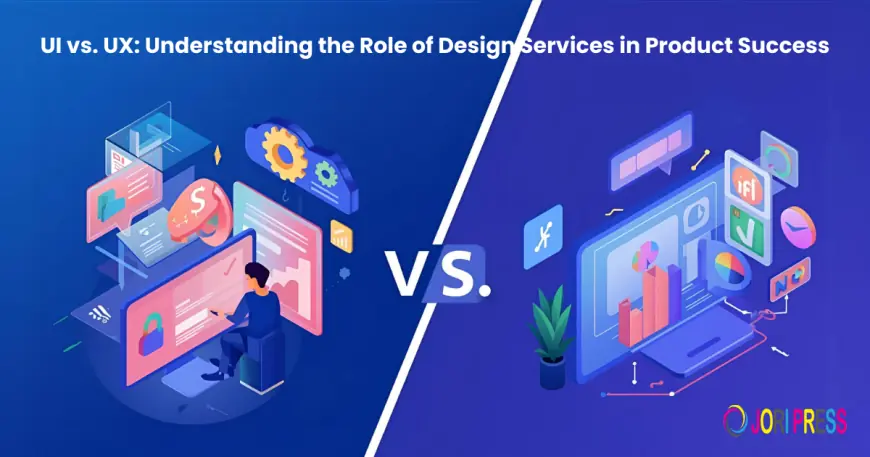UI vs. UX: Understanding the Role of Design Services in Product Success
UI UX Design Services play a vital role in product success by improving usability, enhancing experiences, and driving customer satisfaction.

Creating a successful digital product goes beyond coding and functionality—it’s about how users interact with it. Both UI (User Interface) and UX (User Experience) play pivotal roles, but they serve different purposes. Understanding their roles through UI/UX Design Services can transform an app or website from ordinary to exceptional.
Introduction to UI and UX
Many people mistakenly use UI and UX interchangeably, but they are distinct disciplines:
-
UI (User Interface): Focuses on the visual aspects of a product. This includes layout, buttons, typography, and colors. Essentially, UI is about what the user sees and interacts with.
-
UX (User Experience): Concerns the overall experience of the user, ensuring that interacting with a product is smooth, intuitive, and satisfying.
A product can have a visually appealing interface (UI) but a confusing flow (UX), resulting in frustrated users. Conversely, excellent UX with a poor UI may fail to attract users at all. This shows why both elements must work together to drive product success.
What is UI Design?
UI Design is about making digital products visually engaging and easy to navigate. It includes all the touchpoints that users interact with:
-
Buttons and Icons: Designing interactive elements that are visually clear and guide user actions.
-
Typography and Color Schemes: Selecting fonts, colors, and visual styles that reflect brand identity and improve readability.
-
Layouts and Navigation: Structuring content so users can find what they need quickly.
-
Interactive Elements: Adding visual cues (hover effects, micro-animations) to make the interface feel responsive.
Key principles of UI Design:
-
Visual Hierarchy: Prioritizing elements so users know where to focus first.
-
Consistency: Uniform styles across pages and platforms to avoid confusion.
-
Accessibility: Designing for all users, including those with disabilities, using appropriate contrasts, font sizes, and navigation cues.
In essence, UI ensures that a product looks professional, intuitive, and aesthetically pleasing, which helps capture users’ attention immediately.
What is UX Design?
UX Design is about the user’s journey and experience with a product. It focuses on making the interaction smooth, meaningful, and enjoyable.
Core components of UX Design:
-
User Research: Understanding target users’ needs, behaviors, and pain points through surveys, interviews, and analytics.
-
Wireframing and Prototyping: Creating low- and high-fidelity blueprints to plan the structure and functionality before development.
-
Information Architecture: Organizing content logically so users can navigate the product easily.
-
Usability Testing: Conducting tests with real users to identify problems and refine flows.
Why UX matters: A product with excellent UX reduces user frustration, improves engagement, and ensures the product solves real problems efficiently. It’s not just about looking good—it’s about feeling right to the user.
Key Differences Between UI and UX
|
Aspect |
UI (User Interface) |
UX (User Experience) |
|
Focus |
Visual design, aesthetics, and interactivity |
Overall experience, usability, and satisfaction |
|
Goal |
Attract and engage users visually |
Make the product easy and enjoyable to use |
|
Tools |
Sketch, Figma, Adobe XD |
Wireframing tools, analytics, prototyping software |
|
Deliverables |
Visual mockups, design systems |
User flows, wireframes, prototypes, usability reports |
|
Success Metric |
Look & feel, visual consistency |
Efficiency, engagement, retention, conversions |
Summary: UI is about how a product looks, while UX is about how it works. Both are critical for a product to succeed.
The Importance of UI/UX Design Services in Product Development
Hiring professional UI/UX design services provides several benefits:
-
Improves User Engagement: Intuitive interfaces encourage users to spend more time on the product.
-
Reduces Development Costs: Proper prototyping and UX research prevent costly mistakes during development.
-
Increases Conversion Rates: Smooth user journeys guide users toward desired actions, like signing up or making a purchase.
-
Strengthens Brand Identity: Consistent and visually appealing design builds trust and recognition.
Professional UI/UX services ensure that both aesthetics and functionality are optimized, leading to better adoption and customer satisfaction.
How UI/UX Design Impacts Business Metrics
Investing in UI/UX design has a measurable effect on business outcomes:
-
Conversion Rate: Clear flows and engaging design reduce friction, increasing sign-ups or purchases.
-
Customer Retention: A satisfying user experience encourages repeat visits.
-
Customer Satisfaction: Intuitive interfaces and easy navigation reduce frustration.
-
Revenue Growth: Users who enjoy the experience are more likely to spend and recommend the product.
Statistic: According to research, every $1 invested in UX can return up to $100 in benefits, proving the high ROI of professional design services.
Choosing the Right UI/UX Design Services
Selecting a design partner is critical for product success. Key considerations include:
-
Portfolio & Expertise: Look for experience in similar industries or product types.
-
Design Process: Ensure a structured, user-centered approach, including research, prototyping, and testing.
-
Collaboration: Clear communication and agile workflows are essential for iterative improvements.
-
Post-launch Support: Continuous monitoring and updates help adapt the product based on real user feedback.
The right UI/UX partner ensures that both visual appeal and usability are maximized, contributing directly to business success.
Common UI/UX Design Mistakes to Avoid
Even small design missteps can harm a product’s success. Common mistakes include:
-
Overloading Interfaces: Too many elements confuse users.
-
Ignoring Mobile-First Design: Mobile experiences are critical as most users access products on smartphones.
-
Skipping User Research: Not understanding user needs leads to poor usability.
-
Focusing Solely on Aesthetics: Looks cannot compensate for bad workflows.
-
Inconsistent Branding: Mixed fonts, colors, and styles create confusion and distrust.
Avoiding these mistakes saves resources, improves user satisfaction, and enhances product adoption.
Conclusion
UI and UX are inseparable in creating products that delight users and achieve business goals. While UI captures attention, UX ensures retention and satisfaction. Professional UI/UX Design Services help bridge the gap between technology and user expectations, resulting in products that are beautiful, functional, and successful.
Investing in both UI and UX is no longer optional—it’s a strategic necessity for any digital product aiming for success.
FAQs
Q1. Can a product succeed with great UI but poor UX?
Rarely. Initial attraction may occur, but poor usability leads to frustration and abandonment.
Q2. How long does UI/UX design take?
Small apps may take a few weeks; complex platforms can take several months, depending on research, prototyping, and iterations.
Q3. Are UI and UX always handled by separate teams?
Not always. Some teams combine both roles, but large-scale projects often benefit from specialists in each domain.
Q4. How do UI/UX design services improve ROI?
By optimizing engagement, conversions, and retention, which directly increases revenue and reduces churn.
Q5. Is prototyping necessary for UI/UX design?
Absolutely. Prototyping helps detect usability issues early, saving development time and costs.
What's Your Reaction?
 Like
0
Like
0
 Dislike
0
Dislike
0
 Love
0
Love
0
 Funny
0
Funny
0
 Angry
0
Angry
0
 Sad
0
Sad
0
 Wow
0
Wow
0
















































